Experimental Investigation on the Destruction Features and Acoustic Characteristics of a Brittle Rock Sample Containing Both 2D and 3D Preset Flaws
Abstract
:1. Introduction
2. Laboratory Tests
2.1. Test Design
2.2. Mechanical–Acoustic–Optical Results
2.3. AE Event Locating Results
3. Discussions
3.1. Estimations of Failure Size
3.2. Estimations of Failure Size
3.3. Failure Intensity Estimations Based on the S Value
- (1)
- The relatively high b-values and low S values remain for a long time (0–290 s in the Design-1 sample, 0–275 s in the Design-2 sample, and 0–478 s in the Design-3 sample), which proves that the small and micro-scale destruction continues to develop, and no macroscopic large-scale damage occurs.
- (2)
- Before the final destructions of the sample, the b-values usually decline before the AE rates sharply rise (over 400 events/0.1 s); meanwhile, the S values show the opposite characteristic (290–296 s and 314–315 s in the Design-1 sample, 275–276 s and 277–278 s in the Design-2 sample, and 478.5–479 s in the Design-3 sample). During these periods, the scale of local failure expands, the macroscopic secondary cracks gradually form, and the energy released during the fracture process gradually increases.
- (3)
- When the AE rate reaches its maximum, the b-values and S values oscillate rapidly in a short period of time; the destruction is completed instantly within 0.01 s, which can be considered as the simultaneous generation of multi-scale and multi-level destructions. The duration of this type of period shall not exceed 1 s, and it is also the fastest period of secondary damage development.
- (4)
- AE rates sharply drop after reaching the UCS status of the tests, and the b-values gradually decline in the remaining period, while the S values present the opposite trend (increase) simultaneously. The above results indicate that the size and severity of secondary failures during this period gradually rise, and the macroscale and large-scale destruction ultimately take place.
3.4. Mechanism of AE Events Neighboring to the 3D Internal Flaw before UCS Status
4. Conclusions
- (1)
- The inclination angle of preset twin flaws gradually changes the intensity of the final failure of the sample, surface strain field, and distribution characteristics of secondary cracks. In addition, the internal 3D flaws show little influence on the distributions of the maximum principal strain fields and visible cracks on the sample surface, which are mainly controlled by the 2D preset flaws. The above results are consistent with previous similar test results.
- (2)
- The gradient inclination angle of preset twin flaws shows a slight influence on the distribution of AE events before reaching the UCS status of samples, while the destructiveness of the middle rock between the parallel flaws declines gradually as the flaw inclination angle increases. Furthermore, as the flaw inclination angle increases, the central position of the internal free surfaces (built by the internal 3D open-type preset flaw) is more prone to typical tensile failure, and the boundary position is more prone to shear failure.
- (3)
- Based on the acoustic data monitored by the InSite-Lab system, the long-term accumulation of small-scale damage is observed during the majority of the test duration; there will be clear premonitory features in the b-values and S values before the formation of local failures; the final failures quickly form at various scales and energy levels, then the macroscale destruction dominates in subsequent periods.
- (4)
- When calculating the b-values, the two influencing factors (data window width and moving step length) have little impact on the evaluation results due to the instantaneous occurrence of massive AE signals; in addition, it is suggested to set the bin width of magnitude to 0.5 or 1.0 for obtaining more stable statistical results.
- (5)
- The laboratory test only focused on the failure characteristics of the fractured brittle rock under the uniaxial compression condition, which can only simulate an underground pillar; however, the surrounding rock of underground engineering is mostly in a biaxial or even true triaxial stress state. By applying the true triaxial compressive loading system at Fuzhou University, we will continue to prepare relevant samples (the true 3D preset flaws) in future work and expand the experiment to true triaxial conditions.
Author Contributions
Funding
Institutional Review Board Statement
Informed Consent Statement
Data Availability Statement
Conflicts of Interest
References
- Bobet, A. The initiation of secondary cracks in compression. Eng. Fract. Mech. 2000, 66, 187–219. [Google Scholar] [CrossRef]
- Li, X.; Zhou, T.; Li, D. Dynamic strength and fracturing behavior of single-flawed prismatic marble specimens under impact loading with a Split-Hopkinson Pressure Bar. Rock Mech. Rock Eng. 2017, 50, 29–44. [Google Scholar] [CrossRef]
- Liu, L.; Li, H.; Li, X.; Wu, R. Full-field strain evolution and characteristic stress levels of rocks containing a single pre-existing flaw under uniaxial compression. Bull. Eng. Geol. Environ. 2000, 79, 3145–3161. [Google Scholar] [CrossRef]
- Shan, R.; Bai, Y.; Dou, H.; Han, T.; Yan, F. Experimental study on the mechanical properties and damage evolution of red sandstone containing a single ice-filled flaw under triaxial compression. Arab. J. Geosci. 2020, 13, 630. [Google Scholar] [CrossRef]
- Yang, S.; Jing, H. Strength failure and crack coalescence behavior of brittle sandstone samples containing a single fissure under uniaxial compression. Int. J. Fract. 2011, 168, 227–250. [Google Scholar] [CrossRef]
- Yang, S.; Tian, W.; Huang, Y.; Ma, Z.; Fan, L.; Wu, Z. Experimental and discrete element modeling on cracking behavior of sandstone containing a single oval flaw under uniaxial compression. Eng. Fract. Mech. 2018, 194, 154–174. [Google Scholar] [CrossRef]
- Zhang, X.; Zhang, Q.; Wu, S. Acoustic emission characteristics of the rock-like material containing a single flaw under different compressive loading rates. Comput. Geotech. 2017, 83, 83–97. [Google Scholar] [CrossRef]
- Bobet, A.; Einstein, H. Fracture coalescence in rock-type materials under uniaxial and biaxial compression. Int. J. Rock Mech. Min. Sci. 1998, 35, 863–888. [Google Scholar] [CrossRef]
- Lin, Q.; Cao, P.; Wen, G.; Meng, J.; Cao, R.; Zhao, Z. Crack coalescence in rock-like specimens with two dissimilar layers and pre-existing double parallel joints under uniaxial compression. Int. J. Rock Mech. Min. Sci. 2021, 139, 104621. [Google Scholar] [CrossRef]
- Pan, W.; Wang, X.; Liu, Q.; Yuan, Y.; Zuo, B. Non-parallel double-crack propagation in rock-like materials under uniaxial compression. Int. J. Coal Sci. Technol. 2019, 6, 372–387. [Google Scholar] [CrossRef]
- Zhuang, X.; Zhou, S. An experimental and numerical study on the influence of filling materials on double-crack propagation. Rock Mech. Rock Eng. 2020, 53, 5571–5591. [Google Scholar] [CrossRef]
- Asadizadeh, M.; Hossaini, M.F.; Moosavi, M.; Masoumi, H.; Ranjith, P. Mechanical characterisation of jointed rock-like material with non-persistent rough joints subjected to uniaxial compression. Eng. Geol. 2019, 260, 105224. [Google Scholar] [CrossRef]
- Cao, R.; Yao, R.; Meng, J.; Lin, Q.; Lin, H.; Li, S. Failure mechanism of non-persistent jointed rock-like specimens under uniaxial loading: Laboratory testing. Int. J. Rock Mech. Min. Sci. 2020, 132, 104341. [Google Scholar] [CrossRef]
- Yang, S.; Yin, P.; Zhang, Y.; Chen, M.; Zhou, X.; Jing, H.; Zhang, Q. Failure behavior and crack evolution mechanism of a non-persistent jointed rock mass containing a circular hole. Int. J. Rock Mech. Min. Sci. 2019, 114, 101–121. [Google Scholar] [CrossRef]
- Gerolymatou, E.; Triantafyllidis, T. Shearing of materials with intermittent joints. Rock Mech. Rock Eng. 2016, 49, 2689–2700. [Google Scholar] [CrossRef]
- Jiang, Q.; Cui, J.; Feng, X.; Zhang, Y.; Zhang, M.; Zhong, S.; Ran, S. Demonstration of spatial anisotropic deformation properties for jointed rock mass by an analytical deformation tensor. Comput. Geotech. 2017, 88, 111–128. [Google Scholar] [CrossRef]
- Cao, R.; Cao, P.; Fan, X.; Xiong, X.; Lin, H. An experimental and numerical study on mechanical behavior of ubiquitous-joint brittle rock-like specimens under uniaxial compression. Rock Mech. Rock Eng. 2016, 49, 4319–4338. [Google Scholar] [CrossRef]
- Yang, X.; Jing, H.; Tang, C.; Yang, S. Effect of parallel joint interaction on mechanical behavior of jointed rock mass models. Int Int. J. Rock Mech. Min. Sci. 2017, 92, 40–53. [Google Scholar] [CrossRef]
- Liu, Y.; Dai, F.; Dong, L.; Xu, N.; Feng, P. Experimental investigation on the fatigue mechanical properties of intermittently jointed rock models under cyclic uniaxial compression with different loading parameters. Rock Mech. Rock Eng. 2018, 51, 47–68. [Google Scholar] [CrossRef]
- Lin, Q.; Cao, P.; Meng, J.; Cao, R.; Zhao, Z. Strength and failure characteristics of jointed rock mass with double circular holes under uniaxial compression: Insights from discrete element method modelling. Theor. Appl. Fract. Mech. 2020, 109, 102692. [Google Scholar] [CrossRef]
- Lin, Q.; Cao, P.; Liu, Y.; Cao, R.; Li, J. Mechanical behaviour of a jointed rock mass with a circular hole under compression-shear loading: Experimental and numerical studies. Theor. Appl. Fract. Mech. 2021, 114, 102998. [Google Scholar] [CrossRef]
- Xing, H.; Zahng, Q.; Ruan, D.; Dehkhoda, S.; Lu, G.; Zhao, J. Full-field measurement and fracture characterisations of rocks under dynamic loads using high-speed three-dimensional digital image correlation. Int. J. Impact Eng. 2018, 113, 61–72. [Google Scholar] [CrossRef]
- Xing, H.; Zhang, Q.; Zhao, J. Stress Thresholds of crack development and Poisson’s ratio of rock material at high strain rate. Rock Mech. Rock Eng. 2018, 51, 945–951. [Google Scholar] [CrossRef]
- Liu, B.; Gao, Y.; Jin, A.; Wang, X. Dynamic characteristics of superfine tailings–blast furnace slag backfill featuring filling surface. Constr. Build. Mater. 2020, 242, 118173. [Google Scholar] [CrossRef]
- Fakhimi, A.; Lin, Q.; Labuz, J.F. Insights on rock fracture from digital imaging and numerical modeling. Int. J. Rock Mech. Min. Sci. 2018, 107, 201–207. [Google Scholar] [CrossRef]
- Miao, S.; Pan, P.; Li, S.; Chen, J.; Konicek, P. Quantitative fracture analysis of hard rock containing double infilling flaws with a novel DIC-based method. Eng. Fract. Mech. 2021, 252, 107846. [Google Scholar] [CrossRef]
- Zhang, J.; Zhou, X. AE event rate characteristics of flawed granite: From damage stress to ultimate failure. Geophys. J. Int. 2020, 222, 795–814. [Google Scholar] [CrossRef]
- Zhou, X.; Zhang, J. Damage progression and acoustic emission in brittle failure of granite and sandstone. Int. J. Rock Mech. Min. Sci. 2021, 143, 104789. [Google Scholar] [CrossRef]
- Zhao, Y.; Gao, Y.; Wu, S. Influence of different concealment conditions of parallel double flaws on mechanical properties and failure characteristics of brittle rock under uniaxial compression. Theor. Appl. Fract. Mech. 2020, 109, 102751. [Google Scholar] [CrossRef]
- Zhao, Y.; Gao, Y.; Wu, S.; Chen, L.; Zhang, C. Experimental and numerical study of failure characteristics of brittle rocks with single internal 3D open-type flaw. Acta Geotech. 2021, 16, 3087–3113. [Google Scholar] [CrossRef]
- Lei, R.; Zhang, Z.; Berto, F.; Ranjith, P.; Liu, L. Cracking process and acoustic emission characteristics of sandstone with two parallel filled-flaws under biaxial compression. Eng. Fract. Mech. 2020, 237, 107253. [Google Scholar] [CrossRef]
- Lei, R.; Zhang, Z.; Ge, Z.; Berto, F.; Wang, G.; Zhou, L. Deformation localization and cracking processes of sandstone containing two flaws of different geometric arrangements. Fatigue Fract. Eng. Mater. Struct. 2020, 43, 1959–1977. [Google Scholar] [CrossRef]
- Huang, Y.; Yang, S.; Dong, J. Experimental study on fracture behaviour of three-flawed sandstone specimens after high-temperature treatments. Fatigue Fract. Eng. Mater. Struct. 2020, 43, 2214–2231. [Google Scholar] [CrossRef]
- Zhang, J.; Zhou, X.; Zhou, L.; Berto, F. Progressive failure of brittle rocks with non-isometric flaws: Insights from acousto-optic-mechanical (AOM) data. Fatigue Fract. Eng. Mater. Struct. 2019, 42, 1787–1802. [Google Scholar] [CrossRef]
- Zhao, Y.; Chen, C.; Wu, S.; Guo, P.; Li, B. Effects of 2D&3D nonparallel flaws on failure characteristics of brittle rock-like samples under uniaxial compression: Insights from acoustic emission and DIC monitoring. Theor. Appl. Fract. Mech. 2022, 120, 103391. [Google Scholar] [CrossRef]
- Liu, X.; Pan, M.; Li, X.; Wang, J. Acoustic emission b-value characteristics of granite under dynamic loading and static loading. Chin. J. Rock Mech. Eng. 2017, 36 (Suppl. S1), 3148–3155. [Google Scholar] [CrossRef]
- Gutenberg, B.; Richter, C.F. Frequency of earthquakes in California. Bull. Seism. Soc. Am. 1944, 34, 185–188. [Google Scholar] [CrossRef]
- Scholz, C.H. The frequency-magnitude relation of micro-fracturing in rock and its relation to earthquakes. Bull. Seism. Soc. Am. 1968, 58, 399–415. [Google Scholar] [CrossRef]
- Schorlemmer, D.; Wiemer, S.; Wyss, M. Variations in earthquake-size distribution across different stress regimes. Nature 2005, 437, 539–542. [Google Scholar] [CrossRef]
- Shi, H.; Meng, L.; Zhang, X.; Chang, Y.; Yang, Z.; Xie, W.; Fu, B.; Han, P. Decrease in b-value prior to the Wenchuan earthquake (MS8.0). Chin. J. Geophy. 2018, 61, 1874–1881. [Google Scholar]
- Scholz, C.H. On the stress dependence of the earthquake b-value. Geophys. Res. Lett. 2015, 42, 1399–1402. [Google Scholar] [CrossRef]
- Liu, X.; Han, M.; Li, X.; Chen, D. A new b value estimation method in rock acoustic emission testing. J. Geophys. Res. Solid Earth 2020, 125, e2020JB019658. [Google Scholar] [CrossRef]
- Sheoran, R.; Datt, P.; Shahi, J.S.; Srivastava, P.K. Improvements in the estimation of b value: Limits of the power law. Struct. Control. Heal. Monit. 2022, 29, e3072. [Google Scholar] [CrossRef]
- Dong, L.; Zhang, Y.; Sun, D.; Chen, Y.; Tang, Z. Stage characteristics of acoustic emission and identification of unstable crack state for granite fractures. Chin. J. Rock Mech. Eng. 2022, 41, 120–131. [Google Scholar] [CrossRef]
- Ren, Y.; Vavrycuk, V.; Wu, S.; Gao, Y. Accurate moment tensor inversion of acoustic emissions and its application to Brazilian splitting test. Int. J. Rock Mech. Min. Sci. 2021, 141, 104707. [Google Scholar] [CrossRef]
- Sun, W.; Wu, S. A study of crack initiation and source mechanism in the Brazilian test based on moment tensor. Eng. Fract. Mech. 2021, 264, 107622. [Google Scholar] [CrossRef]
- Petružálek, M.; Jechumtálová, Z.; Kolář, P.; Adamova, P.; Svitek, T.; Šílený, J.; Lokajicek, T. Acoustic emission in a laboratory: Mechanism of microearthquakes using alternative source models. J. Geophys. Res. Solid Earth 2018, 123, 4965–4982. [Google Scholar] [CrossRef]
- Zhao, Y.; Gao, Y.; Wu, S. Experimental and theoretical study of failure characteristics of rock containing single 3D internal open-type flaws. Arab. J. Sci. Eng. 2021, 46, 5071–5088. [Google Scholar] [CrossRef]
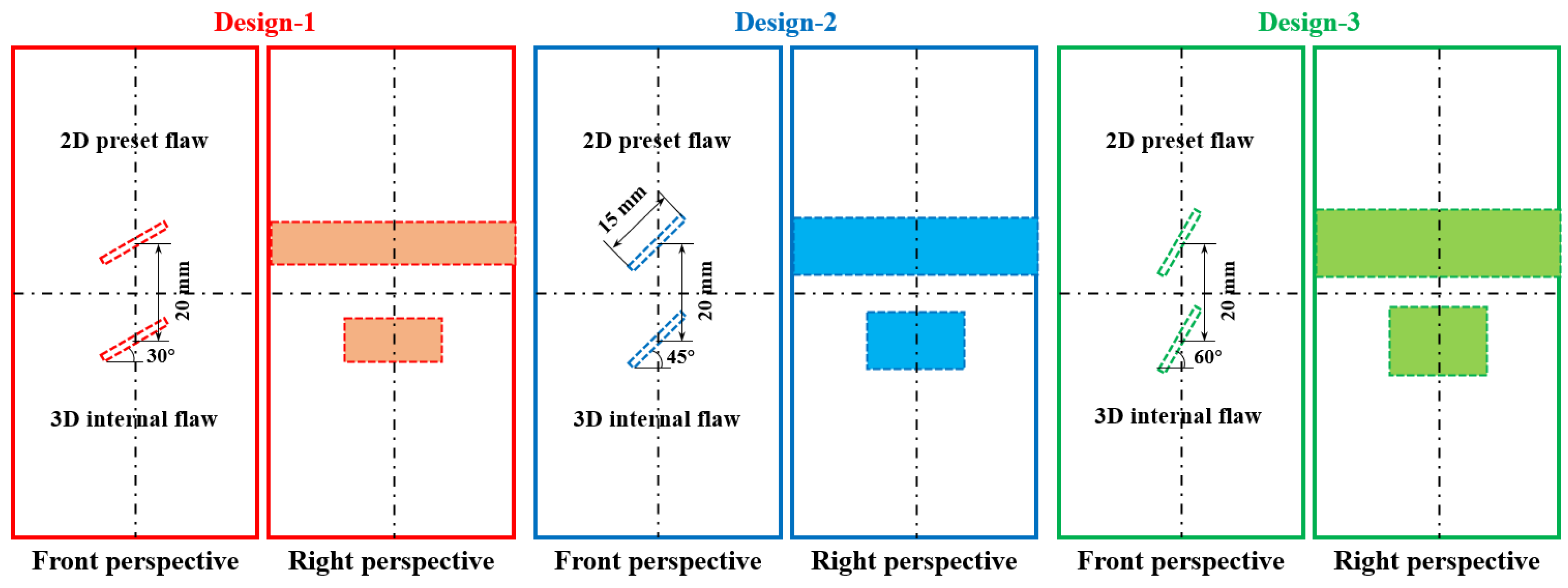
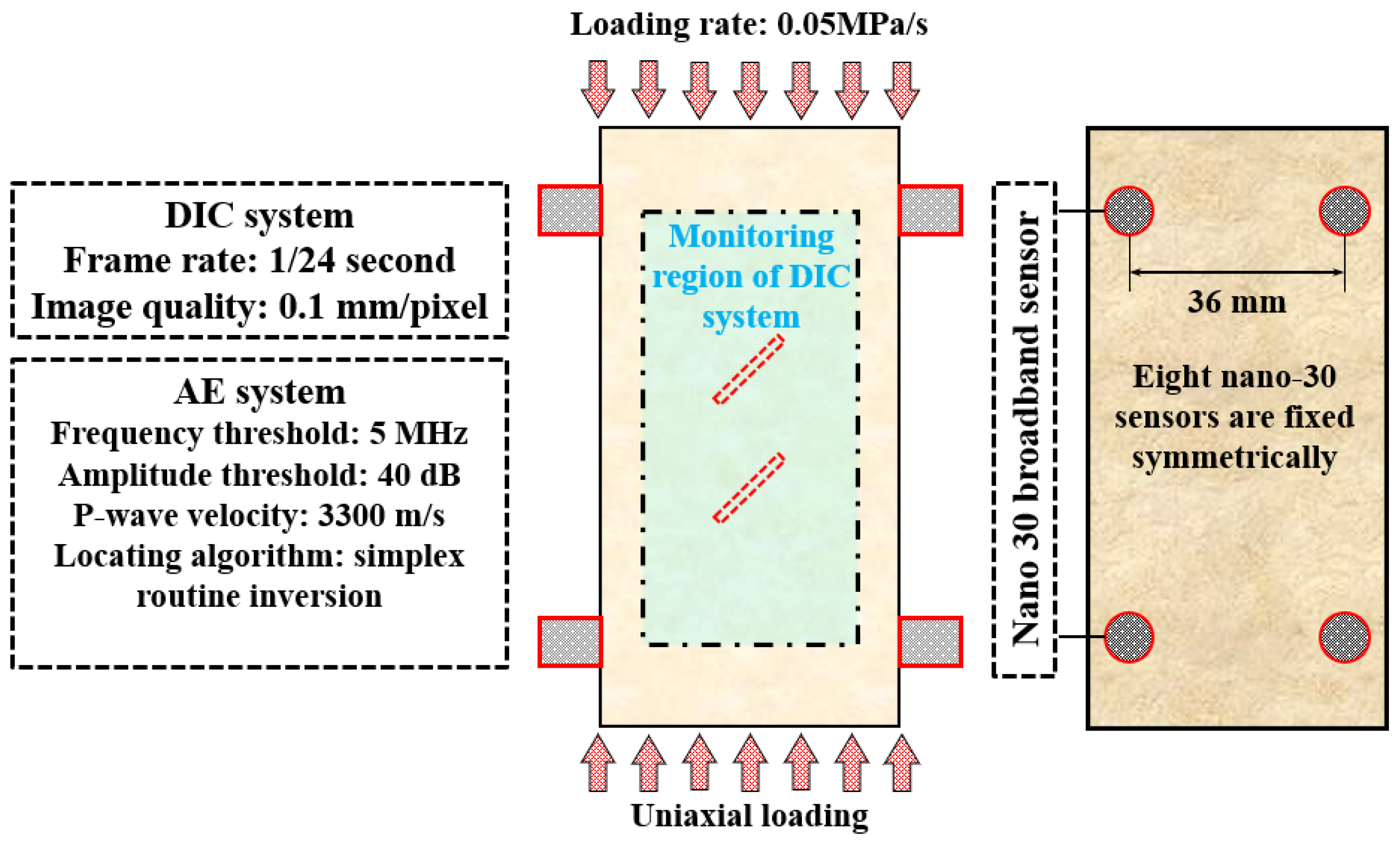



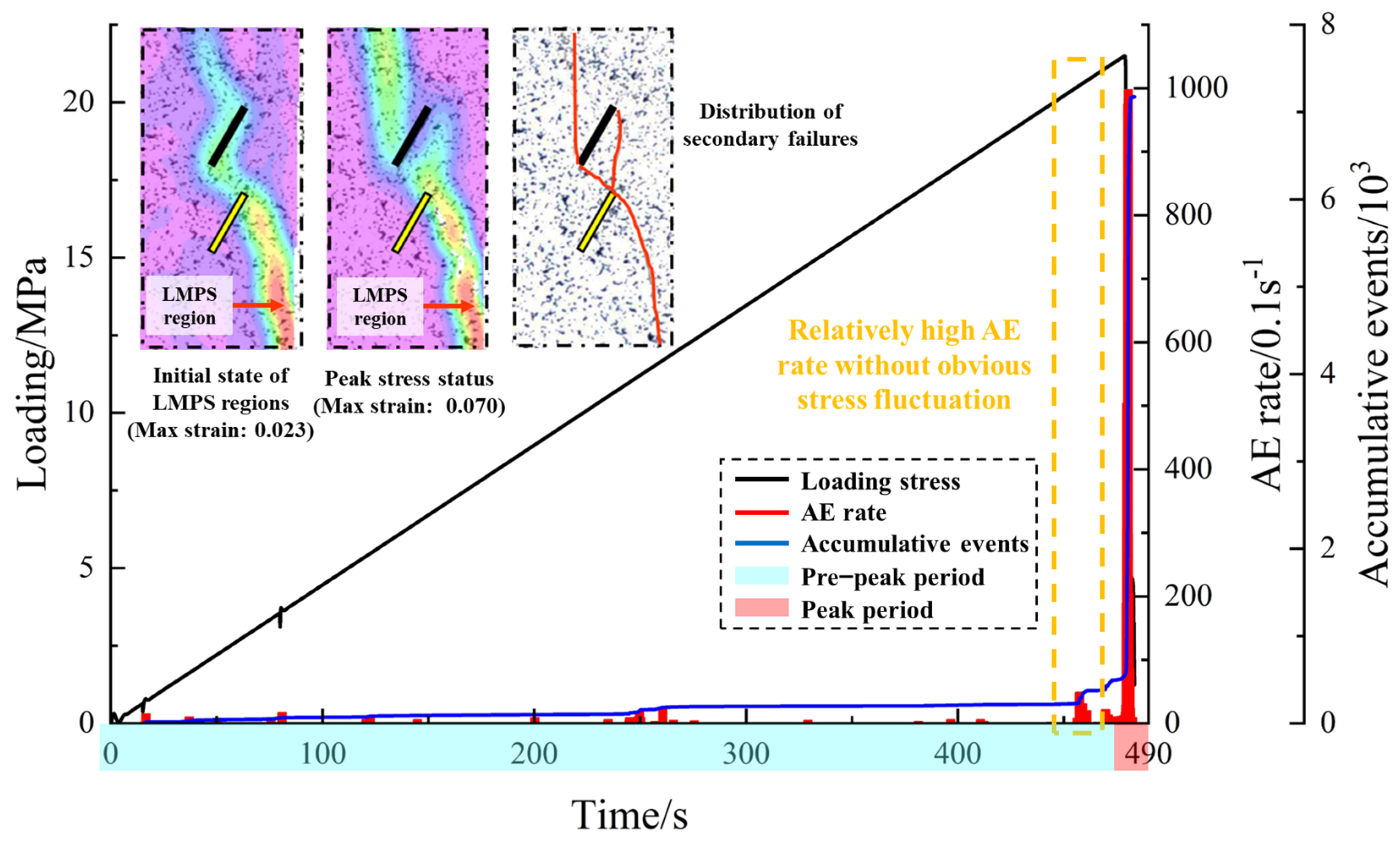
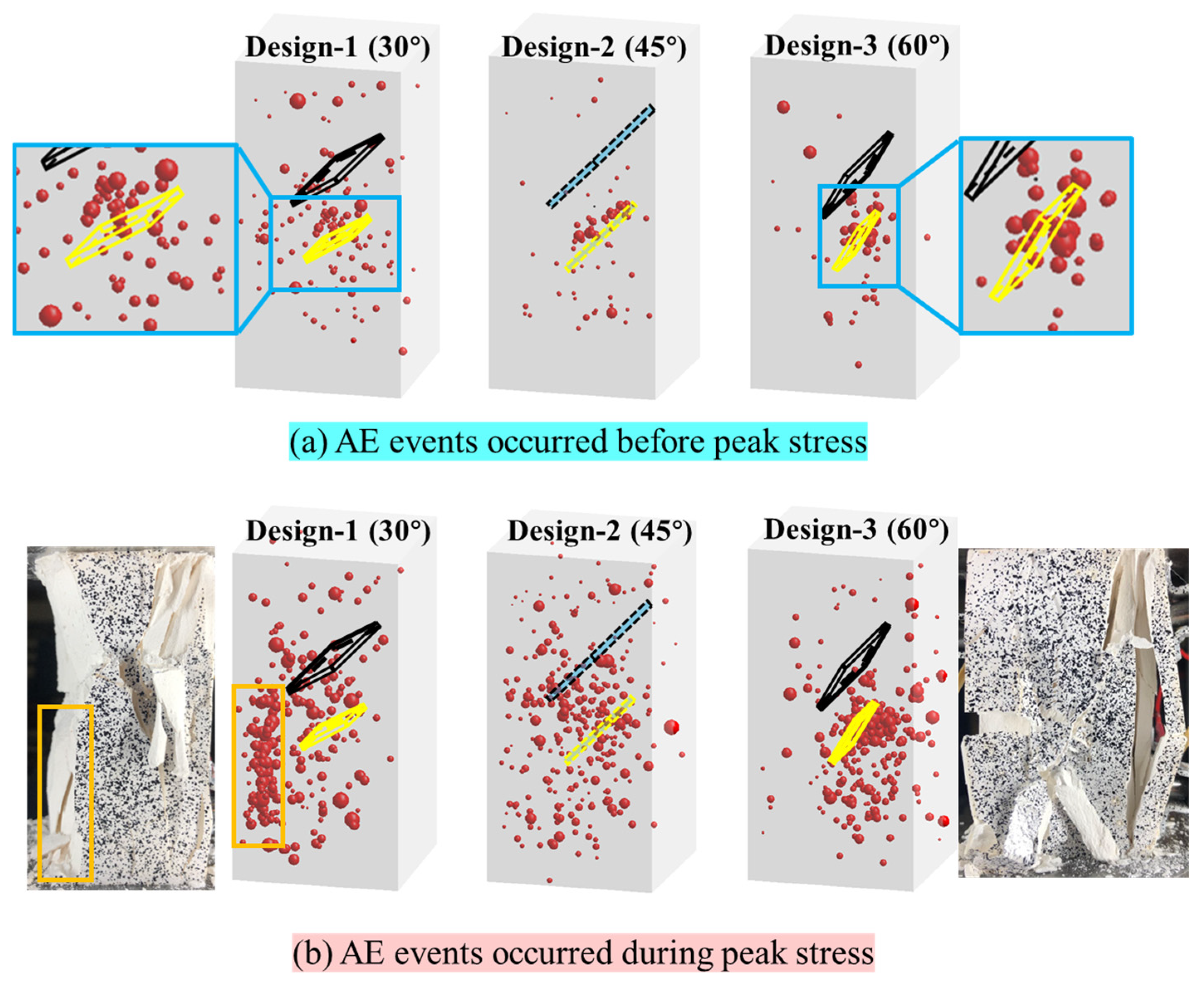
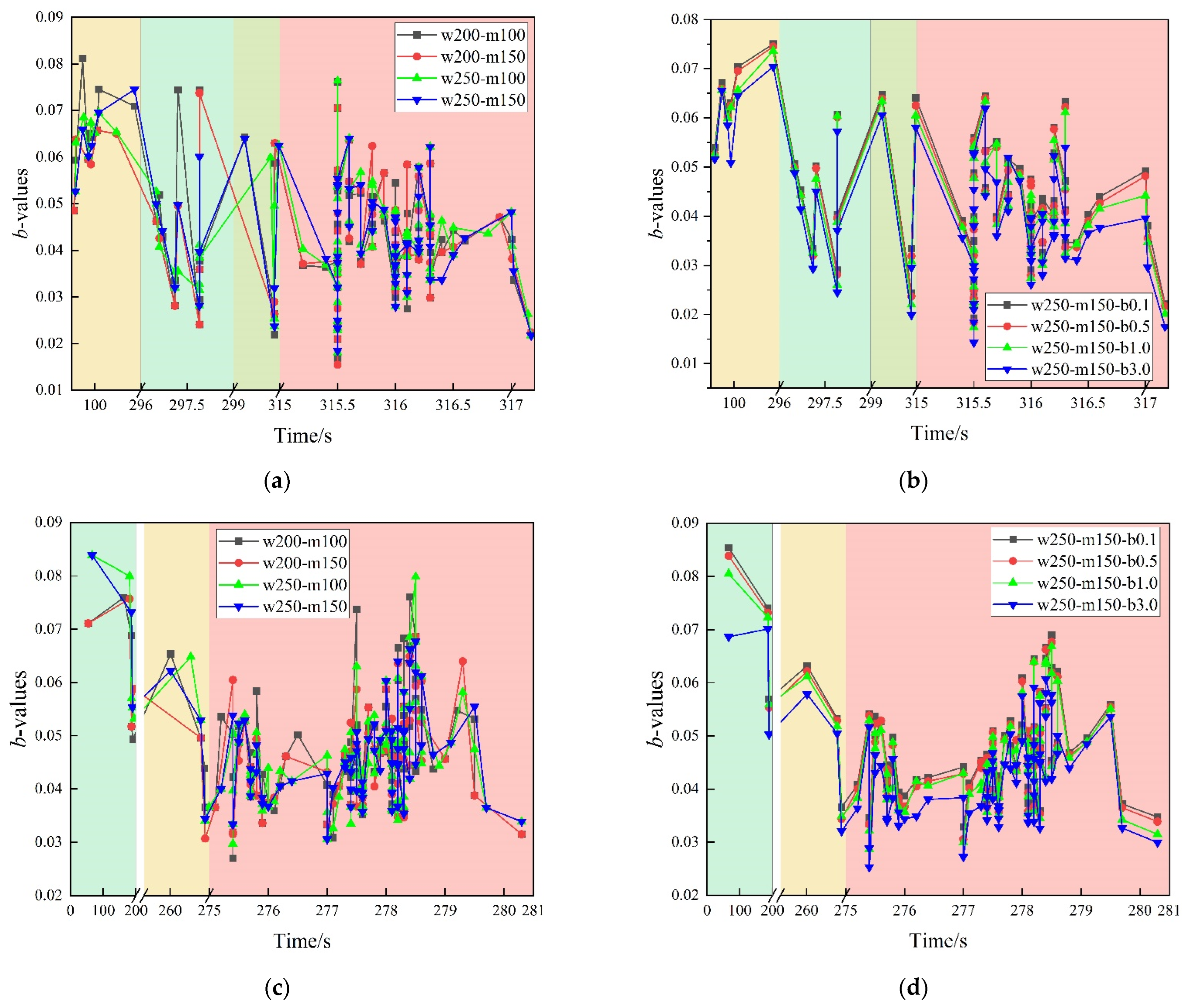



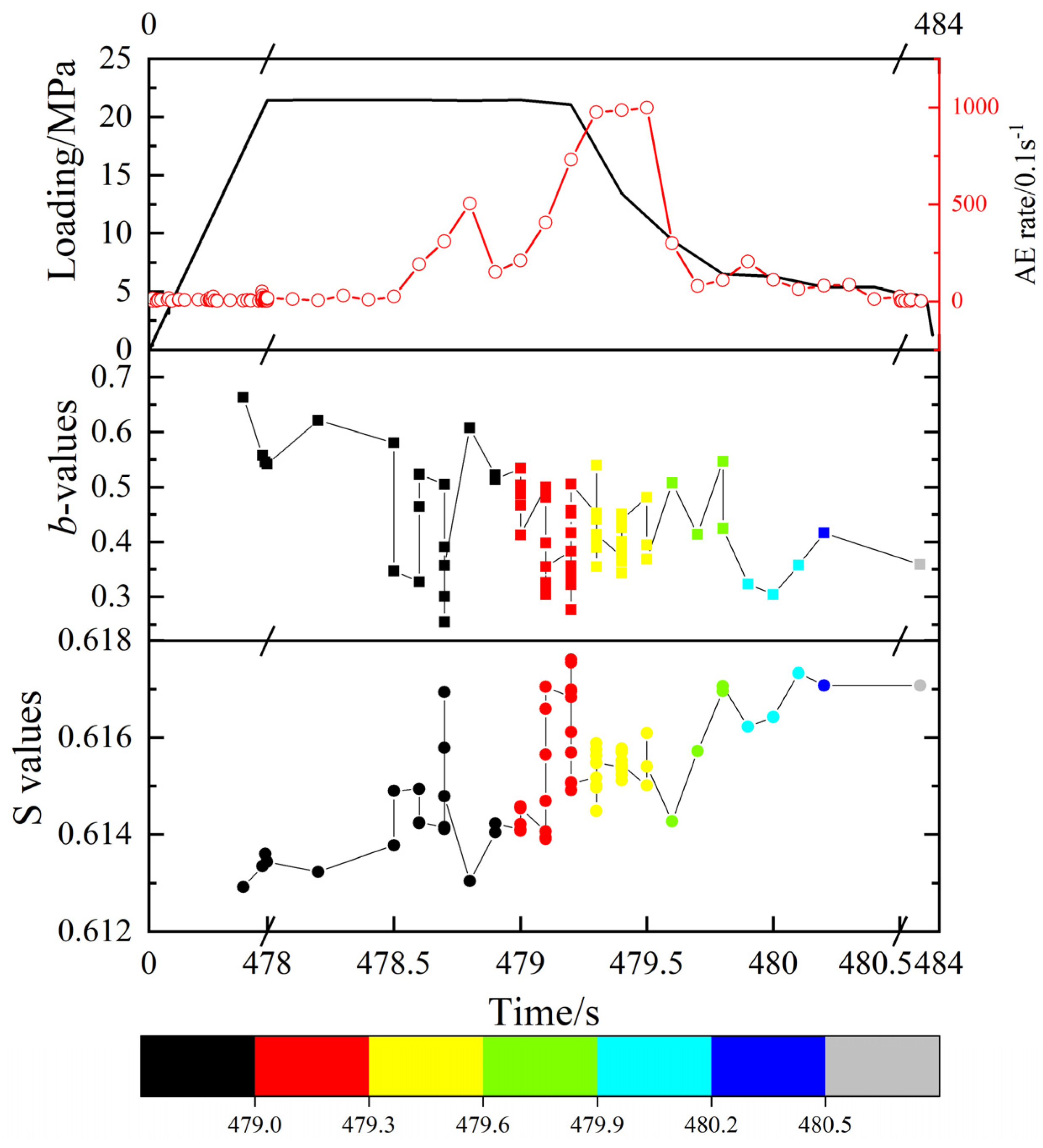

| Chemical composition | α-CaSO4·1/2H2O |
| Mesh number | 2000 |
| Initial setting period/min | ≥3 |
| Final setting period/min | ≤30 |
| 2 h bending strength/MPa | 2.2 |
| 2 h compressive strength/MPa | 4.0 |
| Ratio in weight (%) | Gypsum:water–5:2 |
| UCS (uniaxial compression strength)/MPa | 26.63 |
| TS (tensile strength)/MPa | 1.13 |
| Axial strain at UCS state | 0.17 |
Disclaimer/Publisher’s Note: The statements, opinions and data contained in all publications are solely those of the individual author(s) and contributor(s) and not of MDPI and/or the editor(s). MDPI and/or the editor(s) disclaim responsibility for any injury to people or property resulting from any ideas, methods, instructions or products referred to in the content. |
© 2023 by the authors. Licensee MDPI, Basel, Switzerland. This article is an open access article distributed under the terms and conditions of the Creative Commons Attribution (CC BY) license (https://creativecommons.org/licenses/by/4.0/).
Share and Cite
Luo, T.; Chen, S.; Li, B. Experimental Investigation on the Destruction Features and Acoustic Characteristics of a Brittle Rock Sample Containing Both 2D and 3D Preset Flaws. Appl. Sci. 2023, 13, 12705. https://doi.org/10.3390/app132312705
Luo T, Chen S, Li B. Experimental Investigation on the Destruction Features and Acoustic Characteristics of a Brittle Rock Sample Containing Both 2D and 3D Preset Flaws. Applied Sciences. 2023; 13(23):12705. https://doi.org/10.3390/app132312705
Chicago/Turabian StyleLuo, Tao, Siyu Chen, and Binglei Li. 2023. "Experimental Investigation on the Destruction Features and Acoustic Characteristics of a Brittle Rock Sample Containing Both 2D and 3D Preset Flaws" Applied Sciences 13, no. 23: 12705. https://doi.org/10.3390/app132312705
APA StyleLuo, T., Chen, S., & Li, B. (2023). Experimental Investigation on the Destruction Features and Acoustic Characteristics of a Brittle Rock Sample Containing Both 2D and 3D Preset Flaws. Applied Sciences, 13(23), 12705. https://doi.org/10.3390/app132312705






